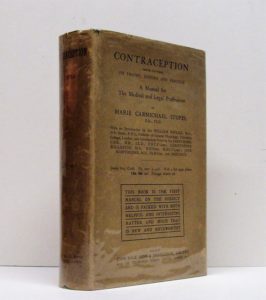
The Grolier Club in New York City had an exhibit dedicated to the works and contributions of women in society. Women for centuries had dedicated their lives to bettering society. For years women’s work have been dismissed or living in the shadows of men, but this exhibition puts on display every kind of work women have done. The item that caught my attention was the book Contraception Its Theory, History, and Practice, A Manual for the Medical and Legal Professions, created by Margret Sanger and Marie Carmicheal Stopes in the early 1900s.
Marie Carmicheal Stopes was the youngest Doctor of Science in Britain, at the age of twenty five. She went on to pursue her career as a paleobotanist, while fulfilling her calling as a life long activist for women’s right. Marie Carmicheal Stopes had left her first marriage due to being unhappy and unconsummated. During this part of her life, she went on to write about sexuality and birth control and its importance in women’s lives. She soon met Margret Sanger, who had exiled herself from London, and spoke about birth control and had decided to come up with something to protect women and men during sex, and for women to choose when they should decide when to have a child. From this came the Sanitary Health Sponge.
The Sanitary Health Sponge was intriguing to me because of its layout, from the packaging to how it looks inside. On the outside, the top had a big red cross as a label. I had found it strange to have chosen a big red cross on it, only because of what the red cross is today. The red cross today signifies a relief organization. It takes care of people in distress and in emergencies. Thinking it through made sense, technically this form of birth control would be saving women from distress and accidental emergencies. The Sanitary Health Sponge came about in the early 1900s, sometime like the 1910s.
Then came Marie Carmicheal Stopes’s book. The title itself was alarming. It was just Contraception in big lettering, then as you look down in smaller letterings is the explanation to the title, how it is used to explain contraception through the eyes of a medical and legal professional. The book itself was published in 1923 in London, during a very much conservative time. What I found a bit strange was how the book is published in London, long after Margret Sanger was self exiled. The book had findings that both Margret and Marie found during the time that their Sanitary Sponge was given to the public.
I have always known that the work of women was overlooked or dismissed, but knowing that the works of women are being displayed somewhere, especially in New York, was a good feeling. If you Google who the first inventor of any form of birth control is, it would say Gregory Pincus with the help of Planned Parenthood in the early twentieth century. It is not until a lot more searching that you’ll stumble upon Stopes and Sanger. Exhibitions like these are important, it shows the power behind women standing for other women, without the help of men.
Works Cited
- https://www.womenshistory.org/education-resources/biographies/margaret-sanger
- Michals, Debra. “Margaret Sanger.” A National Women’s History Museum, www.womenshistory.org/education-resources/biographies/margaret-sanger.
- “Margaret Sanger.” 27 April 2017, www.biography.com/activist/margaret-sanger.
- The Editors of Encyclopedia Britannica. “Marie Stopes.” Encyclopedia Britannica, Encyclopedia Britannica, Inc. www.britannica.com/biography/Marie-Stopes.






